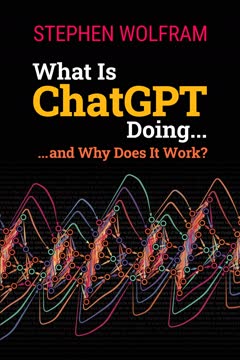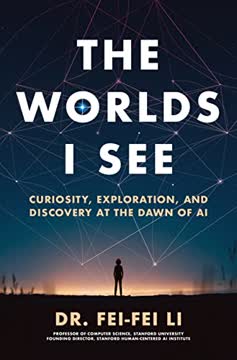Key Takeaways
1. ChatGPT: A revolutionary AI tool reshaping communication and work
ChatGPT is a huge phenomenon and a major paradigm shift in the accelerating march of technological progression.
Paradigm shift. ChatGPT represents a groundbreaking advancement in artificial intelligence, offering a conversational interface that can understand and generate human-like text across various topics and languages. This large language model, developed by OpenAI, has gained unprecedented popularity, amassing over 100 million users within months of its release. ChatGPT's ability to engage in natural language conversations, answer questions, and assist with tasks is reshaping how we interact with technology and approach problem-solving.
Widespread impact. The implications of ChatGPT extend far beyond simple text generation. It's being integrated into numerous applications and industries, from software development and customer service to content creation and data analysis. This versatility is driving a shift in how businesses operate and how individuals approach their work. As ChatGPT continues to evolve and improve, it's likely to become an indispensable tool for enhancing productivity, creativity, and decision-making across various fields.
2. Mastering prompts: The key to unlocking ChatGPT's full potential
ChatGPT's responses are only as good as your prompt.
Prompt engineering. The art and science of crafting effective prompts is crucial for getting the most out of ChatGPT. A well-constructed prompt can guide the AI to provide more accurate, relevant, and useful responses. This skill involves understanding how to frame questions, provide context, and specify desired outcomes.
Strategies for better prompts:
- Be specific and detailed in your requests
- Provide relevant context and background information
- Use role-playing or persona assignment to guide the AI's perspective
- Break complex tasks into smaller, manageable prompts
- Experiment with different phrasings to refine results
Mastering prompt engineering can significantly enhance the quality and usefulness of ChatGPT's outputs, making it a valuable skill for professionals across various industries.
3. ChatGPT's architecture: Understanding the technology behind the magic
ChatGPT uses a multilayer transformer network to generate responses to user prompts.
Transformer architecture. At its core, ChatGPT is built on a sophisticated neural network architecture called a transformer. This design allows the model to process and generate text by analyzing patterns and relationships within vast amounts of training data. The transformer's self-attention mechanism enables ChatGPT to consider context and nuance when generating responses, resulting in more coherent and contextually appropriate outputs.
Key components:
- Large language model (LLM) with billions of parameters
- Training on diverse internet-sourced text data
- Fine-tuning through reinforcement learning from human feedback (RLHF)
- Iterative improvements through user interactions and feedback
Understanding ChatGPT's architecture helps users appreciate its capabilities and limitations, leading to more effective and responsible use of the technology.
4. Evolving models: From GPT-3 to GPT-4 and beyond
GPT-4 is purported to be the largest language model in the world.
Rapid advancement. The progression from GPT-3 to GPT-4 represents a significant leap in AI capabilities. GPT-4 boasts improved performance across various tasks, including language understanding, reasoning, and multimodal input processing. This evolution demonstrates the rapid pace of development in AI technology and hints at even more powerful models in the future.
Key improvements in GPT-4:
- Multimodal capabilities (text and image inputs)
- Enhanced reasoning and problem-solving abilities
- Improved factual accuracy and reduced hallucinations
- Better alignment with human values and intentions
- Increased stability and predictability in outputs
As these models continue to evolve, they're likely to become even more integrated into our daily lives and work processes, offering increasingly sophisticated assistance across a wide range of applications.
5. Ethical considerations and responsible AI development
OpenAI has gone to significant effort to improve the safety of ChatGPT by continuously improving its alignment with human values and goals.
Balancing progress and safety. As AI models like ChatGPT become more powerful and widely adopted, it's crucial to address the ethical implications and potential risks associated with their use. Responsible AI development involves implementing safeguards, promoting transparency, and ensuring that AI systems align with human values and societal norms.
Key ethical considerations:
- Mitigating bias and promoting fairness in AI outputs
- Protecting user privacy and data security
- Addressing potential misuse for malicious purposes
- Ensuring transparency in AI decision-making processes
- Maintaining human oversight and accountability
Ongoing efforts by AI developers, policymakers, and ethical AI advocates are essential for creating a framework that maximizes the benefits of AI while minimizing potential harm.
6. ChatGPT's integration across industries: Transforming professional landscapes
ChatGPT presents users with many business opportunities.
Industry-wide impact. ChatGPT's versatility is leading to its integration across numerous professional fields, transforming how work is done and creating new opportunities for innovation and efficiency.
Examples of ChatGPT applications:
- Software development: Assisting with code generation and debugging
- Marketing: Generating content and analyzing consumer sentiment
- Healthcare: Aiding in research and patient communication
- Legal: Drafting documents and conducting legal research
- Education: Creating personalized learning materials and assessments
- Finance: Analyzing market trends and generating reports
As ChatGPT becomes more deeply integrated into various industries, professionals who can effectively leverage this technology will likely have a significant advantage in their respective fields.
7. Education in the age of AI: Adapting teaching methods and critical thinking
Banning ChatGPT from schools and education programs is a dire mistake.
Embracing AI in education. Rather than viewing ChatGPT as a threat to traditional education, educators should see it as an opportunity to transform teaching methods and enhance learning experiences. By incorporating AI tools like ChatGPT into the curriculum, schools can better prepare students for a future where AI will be an integral part of many professions.
Adapting education:
- Teaching students how to effectively use and critically evaluate AI tools
- Developing curricula that focus on skills AI can't easily replicate (creativity, critical thinking, emotional intelligence)
- Using AI to provide personalized learning experiences and feedback
- Preparing students for a workforce where AI collaboration is commonplace
By embracing AI in education, we can help students develop the skills and knowledge they need to thrive in an increasingly AI-driven world.
8. The future of search: From keywords to knowledge assistants
ChatGPT works by predicting which words will follow your prompt.
Paradigm shift in information retrieval. ChatGPT and similar AI models are transforming how we access and process information. Unlike traditional search engines that rely on keywords to return a list of potentially relevant sources, ChatGPT generates coherent, contextually relevant responses to natural language queries.
Key differences from traditional search:
- Natural language understanding and generation
- Contextual interpretation of queries
- Direct answers rather than lists of sources
- Ability to engage in follow-up questions and clarifications
- Potential for more personalized and intuitive information retrieval
As these AI-powered knowledge assistants continue to evolve, they may fundamentally change how we interact with information and acquire knowledge.
9. Mitigating risks: Fact-checking and maintaining human oversight
Do not mistake an AI model's chatty friendliness with it actually being a friend. It isn't. It's not a person. It's a tool used by people, and as such it's subject to all sorts of mischief as well as helpfulness.
Vigilance required. While ChatGPT and similar AI models offer tremendous benefits, they also come with potential risks, including the generation of inaccurate or biased information. Users must remain vigilant and maintain a critical perspective when using these tools.
Best practices for responsible use:
- Always fact-check important information from multiple reliable sources
- Be aware of potential biases in AI-generated content
- Use AI as a tool to augment, not replace, human judgment and expertise
- Stay informed about the limitations and potential risks of AI models
- Advocate for transparency and ethical guidelines in AI development and deployment
By maintaining human oversight and critical thinking, we can harness the power of AI while mitigating its potential drawbacks.
10. Beyond ChatGPT: Exploring other generative AI tools
ChatGPT is a global phenomenon, but it is not without peers.
Diverse AI landscape. While ChatGPT has garnered significant attention, it's part of a broader ecosystem of generative AI tools, each with its own strengths and applications. Exploring these alternatives can provide a more comprehensive understanding of the current state of AI technology and its potential applications.
Notable generative AI tools:
- DALL-E and DALL-E 2: Image generation from text descriptions
- DeepL Write: AI-powered writing assistance and translation
- Notion AI: Integrated AI for note-taking and project management
- Jasper: AI content creation for marketing and business
- Poe: Customizable AI chatbots for various applications
By familiarizing ourselves with the range of available AI tools, we can better leverage these technologies to enhance our work and daily lives.
Last updated:
FAQ
What's "ChatGPT For Dummies" about?
- Introduction to ChatGPT: The book provides a comprehensive introduction to ChatGPT, a generative AI model developed by OpenAI, explaining its capabilities and how it differs from traditional AI and search engines.
- Practical Guide: It serves as a practical guide for beginners, offering step-by-step instructions on setting up and using ChatGPT effectively in various contexts.
- Applications and Implications: The book explores the wide range of applications for ChatGPT, from professional uses in business and education to personal uses in daily life.
- Ethical Considerations: It also addresses the ethical implications and potential risks associated with using AI, emphasizing responsible use and the importance of understanding AI's limitations.
Why should I read "ChatGPT For Dummies"?
- Comprehensive Overview: The book provides a thorough overview of ChatGPT, making it accessible to those new to AI and those looking to deepen their understanding.
- Practical Tips: It offers practical tips and strategies for using ChatGPT effectively, including prompt engineering and integrating AI into various applications.
- Ethical Guidance: Readers gain insights into the ethical considerations and potential risks of AI, helping them use ChatGPT responsibly.
- Future-Proof Skills: By learning about ChatGPT, readers can develop skills that are increasingly relevant in today's technology-driven world.
What are the key takeaways of "ChatGPT For Dummies"?
- Understanding ChatGPT: Readers will understand what ChatGPT is, how it works, and how it differs from other AI models and search engines.
- Prompt Engineering: The book emphasizes the importance of crafting effective prompts to get the best results from ChatGPT.
- Applications Across Fields: It highlights the diverse applications of ChatGPT in fields like education, business, and daily life.
- Ethical Use: The book stresses the importance of using ChatGPT ethically and responsibly, considering potential risks and limitations.
How does "ChatGPT For Dummies" explain prompt engineering?
- Prompt Basics: The book explains that prompts are the inputs given to ChatGPT, which determine the quality of the output.
- Crafting Effective Prompts: It provides strategies for crafting detailed and specific prompts to guide ChatGPT's responses effectively.
- Prompt Engineering as a Skill: The book discusses prompt engineering as a critical skill, essential for leveraging ChatGPT's capabilities fully.
- Examples and Practice: Readers are given examples and encouraged to practice writing prompts to improve their skills.
What are the ethical considerations discussed in "ChatGPT For Dummies"?
- Responsible AI Use: The book emphasizes the importance of using AI responsibly, considering the potential for misuse and harm.
- Privacy Concerns: It discusses privacy issues, warning users about the data they input into ChatGPT and how it might be used.
- Bias and Misinformation: The book addresses the risks of bias and misinformation in AI outputs and the need for critical evaluation of AI-generated content.
- Legal Implications: It touches on legal considerations, such as copyright issues related to AI-generated content.
How does "ChatGPT For Dummies" suggest using ChatGPT in education?
- Personalized Learning: The book suggests using ChatGPT to create personalized learning experiences, adapting content to individual student needs.
- Critical Thinking Development: It encourages using ChatGPT to develop students' critical thinking skills by crafting thoughtful prompts.
- Educator Support: ChatGPT can assist educators by automating tasks like grading and lesson planning, freeing up time for more personalized teaching.
- Avoiding Misuse: The book advises on preventing misuse, such as cheating, by integrating ChatGPT responsibly into educational settings.
What are the professional applications of ChatGPT according to "ChatGPT For Dummies"?
- Business Efficiency: ChatGPT can automate routine tasks, enhance customer service, and assist in data analysis, improving business efficiency.
- Legal and HR Support: It can draft legal documents, summarize complex information, and assist in HR functions like recruitment and onboarding.
- Marketing and Content Creation: The book highlights ChatGPT's role in generating marketing content, conducting sentiment analysis, and personalizing customer interactions.
- Healthcare and Research: ChatGPT can aid in medical research, patient education, and managing electronic medical records.
How does "ChatGPT For Dummies" address the limitations of ChatGPT?
- Hallucinations and Errors: The book warns about ChatGPT's tendency to produce confident but incorrect responses, known as hallucinations.
- Data Limitations: It notes that ChatGPT's knowledge is limited to the data it was trained on, which may not include the most current information.
- Context Sensitivity: ChatGPT's responses can vary based on how prompts are phrased, requiring careful crafting of inputs.
- Ethical and Legal Risks: The book discusses potential ethical and legal risks, such as privacy concerns and intellectual property issues.
What are the future implications of ChatGPT as discussed in "ChatGPT For Dummies"?
- Job Market Impact: The book explores how ChatGPT might change the job market, potentially automating some roles while creating new opportunities.
- AI Integration: It predicts increased integration of AI into everyday applications, transforming how we work and interact with technology.
- Superapps and Connectivity: The book suggests that ChatGPT could lead to the development of superapps, integrating multiple functions into a single platform.
- Societal Changes: It considers broader societal changes, such as shifts in education, media, and public trust, driven by AI advancements.
What are the best quotes from "ChatGPT For Dummies" and what do they mean?
- "ChatGPT is a harbinger of immense and permanent change." This quote highlights the transformative potential of ChatGPT in various aspects of life and work.
- "Someone good at using AI will take jobs away from most people." It underscores the importance of learning to use AI effectively to remain competitive in the job market.
- "AI is not going to take jobs away from most people. Someone good at using AI will." This emphasizes the need for individuals to adapt and learn AI skills to thrive in the future.
- "The hardest part is stretching your own imagination to allow yourself to reach further with each new project." This encourages readers to think creatively and push the boundaries of what they can achieve with AI.
How does "ChatGPT For Dummies" suggest mitigating risks and liabilities associated with AI?
- Fact-Checking Outputs: The book advises always fact-checking AI-generated content to ensure accuracy and reliability.
- Human Oversight: It recommends maintaining human oversight in AI applications, especially in critical areas like healthcare and legal services.
- Transparency and Disclosure: Users should disclose when AI is used in content creation to maintain transparency and trust.
- Compliance and Monitoring: The book suggests ensuring AI use complies with relevant laws and regulations and monitoring audience feedback for potential issues.
What are the different types of AI models discussed in "ChatGPT For Dummies"?
- Generative AI Models: The book explains generative AI models like ChatGPT, which create new content rather than just analyzing existing data.
- Transformer-Based Models: It discusses transformer-based models, which are crucial for understanding context and generating coherent text.
- Multimodal Models: The book introduces multimodal models like GPT-4, which can process both text and images, expanding AI's capabilities.
- Other AI Tools: It also covers other AI tools and models, such as DALL-E for image generation and DeepL for language translation, highlighting their unique features and applications.
Review Summary
ChatGPT For Dummies receives mixed reviews, with an average rating of 3.39 out of 5. Readers appreciate its comprehensive overview of ChatGPT and AI, praising its clarity and accessibility for beginners. The book covers ethical concerns, practical applications, and future implications of AI. Some find it informative and well-structured, while others feel it lacks depth in certain areas, particularly prompt engineering. Critics note that the information may become outdated quickly due to the rapidly evolving nature of AI technology. Overall, it's considered a useful introduction to ChatGPT for those new to the topic.
Similar Books










Download PDF
Download EPUB
.epub digital book format is ideal for reading ebooks on phones, tablets, and e-readers.




